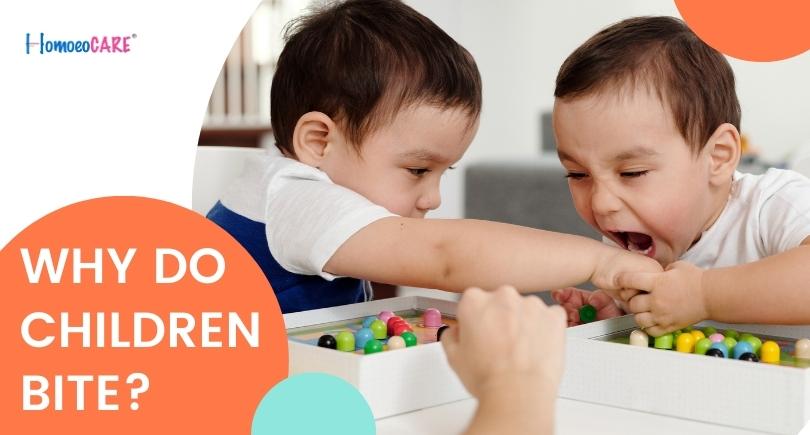
Biting is a major concern among parents of young children. It can be a difficult and frustrating experience, prompting a search for practical solutions. Simply shouting at the child and expecting discipline will not work. Instead, it is important to understand the underlying causes of biting behaviour, whether physiological or emotional. This article explores the various reasons why a child bites and how you can differentiate the cause based on their expressions. This understanding is crucial for finding effective homeopathic treatments for biting in children.
The most common cause of biting can be divided into 2:
1. Physiological Biting
Physiological biting is a normal part of a child's development, with no major problems. It is often due to teething issues or the child's natural exploration needs.
2. Pathological Biting
Pathological biting is less common and is associated with communication problems when the child cannot express their emotions effectively. It may also be a defence mechanism when the child struggles to communicate.
This phenomenon is commonly observed in children aged 6 months to 2 years. During this period, children are naturally curious and constantly explore their surroundings. They often use their mouths, similar to their hands, to explore objects. It is common for children to put various objects into their mouths as their first reaction when given a toy.
Expression – Mouthing.

Teething typically occurs between 6 months and 2 years of age in some children, leading to discomfort as teeth erupt. The child's gums may become swollen and red, causing discomfort and pain. To alleviate the sore gums, children may resort to biting objects or soft items. This biting behaviour is unintentional and periodic, occurring only during the teething process.
Expression – Biting objects, soft things.

This behaviour is commonly observed in children aged 1 to 5 years. For toddlers and preschoolers, biting can serve as a means of expressing intense emotions when they are unable to vocalize their feelings. When children experience emotions such as anger, insecurity, or excitement, or when they need attention but cannot effectively express themselves, they may resort to biting. These children often struggle with impulse control and find it difficult to refrain from biting.
Expressions – Strong, uncontrolled biting:
Many parents react to their child's strong, uncontrolled biting behaviour with anger and punishment. However, this approach is ineffective and may exacerbate the situation, leading to further biting incidents. It is important to understand the underlying cause of the biting behaviour. By addressing the root cause, parents can effectively manage their child's behaviour.
Biting is a defence mechanism of the child, easily understood through observation.

If the child feels angry about something, they may bite the perceived source of anger. This anger may be manifested by tightly clenched jaws, furrowed brows, narrowed eyes, and flushed cheeks. Biting in this context is often forceful and rapid.

When the child feels insecure about something or some situations, they may express it through biting. Signs of fear or insecurity may include wide eyes, welling tears, trembling lips, and whimpering sounds. In this scenario, bites may be hesitant or defensive, directed towards whoever the child perceives as a threat.
Sometimes, the child may bite to seek attention from parents. Look for a playful grin, seeking eye contact, followed by giggles when the child bites. Bites in this context may be gentle or playful, often directed at a parent’s arm or leg.
One major cause of biting, commonly seen in children with autism, is sensory needs. When a child with autism demonstrates hypo-functioning of the oral sensory system, they may resort to various oral sensory-seeking behaviours such as licking, mouthing, and biting. Homeopathic medicine has shown remarkable results in addressing such cases of autism.

Reacting angrily to biting incidents can escalate the situation and reinforce negative behaviour patterns. Handle the situation calmly without any anger. Children often respond best to a composed and reassuring approach.
Address biting incidents promptly and consistently. Ignoring the behaviour may signal to the child that biting is acceptable or go unaddressed. Children often respond best to a composed and reassuring approach. Establish consistent consequences for biting, such as a brief time-out or loss of privileges. Ensure that the consequences are age-appropriate and applied consistently.
Homeopathic treatment focuses on a holistic approach where the child's physical, emotional, and psychological well-being are taken into account. In homeopathy, understanding the root cause of biting behaviour helps address the biting problem in a child. It is important to search for a good homeopathic doctor near you who will try to understand the basic cause of biting and then guide you with the best homeopathic medicine for biting, depending on the cause.
It is important to underline that the best homeopathic doctor should select the most appropriate homeopathic remedy based on a thorough evaluation of the child's individual needs. However, here are some commonly used homeopathic remedies for biting:

If you're interested in using homeopathy to address your child's biting behaviour, consider searching for the best homeopathic doctor near you to access a full list of qualified and trained professionals. Another alternative is to start online homeopathic treatment at HomoeoCARE, where you can find the best-trained homeopathic doctors.
If the child is exhibiting biting symptoms as part of Autism behaviour, HomoeoCARE offers the best homeopathic treatment for autism. You can visit our testimonial page, where we have demonstrated the effectiveness of homeopathic treatment in autism.
Biting behaviour in a child arises from various physiological and emotional factors. By identifying these underlying factors and understanding the expressions of biting, a homeopathic doctor can determine the best homeopathic treatment. Through a deeper understanding and a constitutional homeopathic approach, biting behaviour can be effectively managed, promoting the healthier emotional and developmental well-being of your child.
Copyright ©2021 Homoeocare